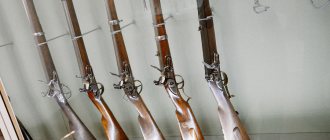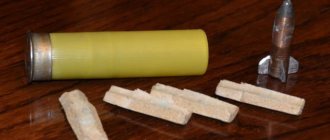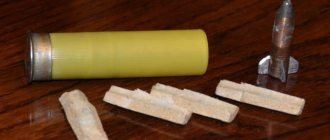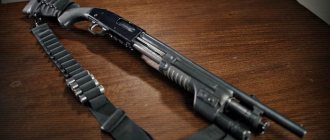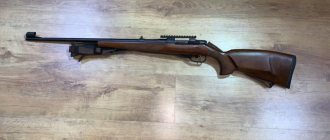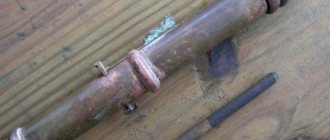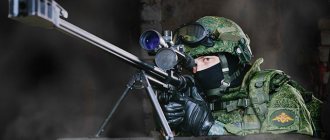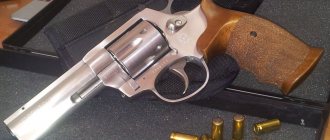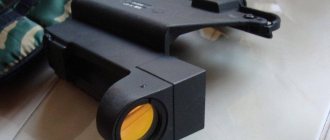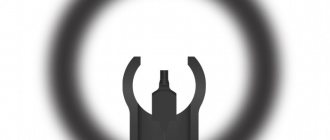For those who literally cannot imagine their life without weapons and hunting, the question of how to choose the right scope is very relevant. This is not surprising, because regardless of whether the hunter is tracking a wild boar, a hare, or any other game, this element performs many functions that allow the hunter to aim and make accurate shots. The choice of a scope should be made based on many factors, and you need to approach the choice as intelligently as possible. First you should find out what types of sighting devices exist for hunting.
The following varieties are mainly used for hunting:
- collimator;
- optical;
- laser;
- night vision scopes.
Each of the listed types of sights has both its advantages and disadvantages, as well as operating features and varying effectiveness. Below is more detailed information about each of them.
Collimator sights for hunting
Such models are used for driven hunting, usually for shooting at short distances. The main advantage of a red dot sight for shotguns is its versatility. Due to the peculiarities of its design, such an optical device can significantly increase efficiency when shooting at moving targets. Also, the collimator sight allows you to freely move your head and change the viewing angle without completely losing sight of the animal. Suitable for both wild boar and smaller targets.
A distinctive feature of collimator sights is the presence of an aiming mark with a pronounced bright dot, which appears due to the operation of an LED. Depending on whether any power source is used in the design of the collimator optical device, they are classified into passive and active.
Passive sights do not have a power source and can be used at any time of the day. Active species operate at the expense of a food source.
In addition, collimator sights for hunting differ in design features, according to which they are divided into two types: open and closed. Closed models are made in a tube-like body. The optical system and the reticle emitter are located inside it. Closed collimator sights are characterized by smaller size and weight. The mark is clearly visible even on a very bright sunny day.
In order for shooting to be carried out correctly and accurately, after installing a collimator sight, careful shooting is necessary, especially if a smooth-bore weapon is used for hunting.
Selecting a red dot sight
Collimator sights, as a rule, are chosen for installation on carbines and shotguns for driven hunting of wild boar and other animals. The peculiarity of this method of hunting is that the hunter is constantly moving. The appearance of an animal is always sudden, and therefore aiming and shooting is carried out very quickly. Optical devices are not suitable for this type of hunting, since an animal that runs away from the shooter very quickly leaves the field of view. The difference between the collimator version is that it allows you to quickly monitor the environment.
The choice of a collimator sight should be based on the following factors:
- availability of nutrients;
- device design (open or closed);
- its weight, since when shooting offhand the balance of a smoothbore gun should not be disturbed;
- type of aiming mark;
- types of mounting used (can be found in the documentation included with the sight);
- design features of the gun/carbine;
- acceptable cost.
These features should definitely be taken into account so that the selected collimator sight is of high quality and allows you to aim as accurately as possible.
Types and best models of sights for smoothbore
So, having dealt with the limitations on cartridge power related to the accuracy of a smoothbore gun - distance and, as a result: hunting options, we will consider all types of sights and models of sights suitable for a smoothbore.
Optical sight for smoothbore weapons
An optical sight on a shotgun will most likely disappoint the hunter: unnecessary magnification for short distances will reduce the field of view and complicate aiming.
However, the use of such sights is justified in the following cases:
- for sports or amateur target shooting;
- to increase accuracy when firing a bullet at the maximum distances for a smoothbore (about one hundred meters);
- for hunters with low vision.
Optical sights of variable magnification on smooth-bore weapons are used in driven hunting. A small magnification provides a wide field of view for quickly identifying an animal, and a small magnification (usually up to 4 times) helps to aim more accurately at medium distances.
Below we list the best models of optical sights for smooth-bore weapons.
More details about the sight: PO 3.5x20 Pilad, Pilad 3.5x20S (without diopter adjustment), Civilian analogue of the legendary sight PU 3.5x22
Due to its low cost, lightness and reliability, the Vologda PO 3.5x20 sight is one of the most popular optical sights for smoothbore guns
More information about the sight: Optical sight Hakko Hunter 1-4×20 (BNL-1420)
Universal
and the inexpensive Hakko Hunter 1-4×20 variable magnification optical sight can withstand the recoil of any smoothbore caliber.
More details about the scope: Hunting scope PO 4x24 P
Optical sights from the Novosibirsk plant are the standard of reliability. A new series of sights PO with the letter P - designed for installation on Picatinny and Weaver rails. This quick-release mount will allow you to quickly replace the sight, for example, with a collimator one. If the weapon does not have a factory rail, a bracket is used to position the barrels horizontally or vertically.
More information about the sight: PO 4x24 - for the Tiger (TG3) carbine, PO 4x24-1 - for the Saiga and Vepr carbines
The PO 4x24 optical sight is a civilian analogue of the PSO-1 army sight. They were developed for use with the AK assault rifle and the SVD rifle. Of course, they can withstand both Lancaster and 12 gauge calibers. The advantage of these sights for use with powerful smoothbore cartridges is that they are monolithic with the sight body, which ensures the best stability of the sight. Please note that these scopes do not have diopter adjustment.
And yet, we recommend installing a collimator sight on smooth-bore Saiga and Vepr, which allows you to quickly find the target after each shot, which increases the speed of fire - the main advantage of smooth-bore AKs.
Much more often, collimator sights and night vision sights are used on smooth-bore weapons.
Collimator sight for smoothbore weapons
A collimator sight usually does not have magnification and is convenient for shooting both shot and bullet at distances of up to 100 meters, which is more than enough for any smooth-bore weapon. You can read more about this type of optical device in the article “How to choose a red dot sight.” As for the smoothbore, let us once again recall the limitation on muzzle energy. Be sure to take this factor into account so that the mark of the sight does not get lost or the sight itself does not fall apart on the weapon (which actually happens with cheap models).
Additionally, we recommend that owners of powerful smooth-bore weapons choose sight models in a housing made with a bracket, which avoids additional fastening elements - rings.
Regarding the belief of many hunters regarding an open collimator sight that such a sight becomes clogged more often than a closed collimator, we briefly note that this is true, for example, during a snowfall. However, when choosing a closed sight, you lose in the viewing angle, which is wider with an open sight.
Thus, for cross-country hunting, we definitely recommend an open red dot sight. The same applies to the use of smooth-bore weapons for self-defense.
Next, we selected the most optimal models taking into account muzzle energy:
Pilad P1x42 Weaver reflex sight. The sight has 3 reticle options and an automatic shutdown mode. More details... And the most important feature of this sight is that, in addition to the Weaver, it is available in two more body options, including a dovetail and a ventilated rail.
The compact and lightweight Japanese collimator sight Hakko BED-35 Panorama also has a MR-02 mark changing system (4 marks) and 7 steps of brightness adjustment. The thinnest body that holds the lens literally dissolves while aiming and focusing on an object, providing a panoramic view of the target. This is very convenient when shooting at moving targets, such as birds.
The American Rubicon collimator sight from Bering Optics is no less compact and has an adjustable backlight, which is more convenient for those who do not like the “surprises” of automation. The scope has a universal 3 MOA mark, which is suitable for both slug and shot hunting. Its analogue with auto-adjustment of the brightness of a larger mark (5 MOA, for game birds) is OP-LA Reflex.
Night vision scope for smoothbore weapons
Hunting for nocturnal animals is popular in Russia. It is difficult to hunt long distances in the dark, so smoothbore shotguns with their short range are often used for this type of hunting. To select a night vision scope, keep in mind that the sighting distance of a smooth-bore weapon will be short, so you should not chase expensive 2nd or 3rd generation image intensifier sights and, especially, thermal imager sights. However, when hunting at night you don’t have to shoot at a greater distance (for more details, see the article “Night Vision Scope for 12 Gauge”). Thus, it is more practical to use 1st generation sights, which allow you to aim up to 150 meters. But here, as with collimator sights, the muzzle energy of the weapon is important. Not all 1st generation scopes can withstand heavy recoil. If we consider the most popular 12 gauge. Of the ones currently available for sale, only the Vologda PNS 3.5x50
Night sight PNS 3.5×50. Manufactured by the Vologda Optical-Mechanical Plant. The sight has a very clear image. Read more..
For a long time, the leader in this segment was the Dedal 180HR sight and the no less reliable PN-2M, but, unfortunately, both sights are currently out of production.
Separately, it is worth noting digital night vision sights. Their design eliminates the glass bulb of the image intensifier tube, and therefore digital cameras can withstand any recoil. The first samples of digital sights were much inferior to sights with image intensifier tubes in the viewing angle and, which is important for smooth-bore weapons, in price. Now the cost of digital sights has decreased and continues to decrease, and if you have the opportunity, we recommend considering the option of purchasing an inexpensive digital one.
The Yukon Sightline N455 digital night vision sight eliminates the “diseases” of the first digital cameras, such as instability of batteries and display at low temperatures and a small viewing angle. The clear, high-contrast image of the sight is much better than any sight with a 1st generation image intensifier at distances up to 150 meters. Read more..
Pulsar Digisight N455 LRF is equipped with a laser rangefinder. The accuracy of a smoothbore gun's fire greatly depends on the distance. For your gun and bullet, you determine the maximum permissible distance and when hunting it is easier to prevent an early shot by allowing the animal to get closer. Read more..
Night vision devices are the specialty of our company. We can talk a lot about the operating features of night vision sights, so materials on this topic have been included in a separate article - about choosing a night sight for smooth-bore weapons.
Optical sights
Optical sights are characterized by very high accuracy. This is due to the fact that they use a very complex optical system, which takes into account many different factors. The conditions in which the sight will be used and even the type of hunting weapon on which it is placed are also taken into account.
This type of optics for shotguns is in wide demand and is used by both beginners and experienced hunters. The optical sight will be properly used for shooting at long distances. In addition, such models allow you to monitor a wild boar or other animal.
Advantages of optical sights:
- a significant distance at which you can make accurate shots from a hunting weapon;
- reliable and durable design;
- clear image regardless of weather conditions;
- compactness and practicality;
- ease of operation.
The disadvantages of optical sights include their higher cost, as well as complex settings that require careful zeroing, especially when shooting at long distances.
Optical sight selection
When choosing an optical sight for a shotgun or rifle, there are many factors to consider. As a rule, such a sighting device is used for blind hunting, during which the hunter remains in one position for a long time, waiting for the animal to appear.
This method of hunting allows you to aim correctly by carefully choosing the point of entry of the bullet. This makes it possible to kill a wild boar or other large animal with one shot, especially since most often the animal is not aware of the presence of the hunter.
When choosing an optical sight for shotguns, you should consider the following features:
- Multiplicity. This indicator determines the degree of approach of the object. It can be variable or constant, depending on the ability of the device to zoom in or out of the image. The simplest models have a magnification of 1.5x to 4x and bring closer to no more than 30 meters. Such models are suitable if shooting is carried out from a weapon with a short range. The optimal option for shooting at long distances is from 16x to 30x; such devices allow you to make an accurate shot from a gun or carbine at a distance of more than 600 meters.
- Entrance pupil. The diameter of the pupil determines the light sensitivity of the optical sight. If this indicator is high, the hunter will be able to clearly see the prey at a great distance even in very poor lighting, for example, at dusk or in cloudy weather.
- Fastening. When choosing optics, it is important to pay attention to the mount with which it is fixed to the weapon. It must be as strong and reliable as possible, since if the sight is poorly secured, it will vibrate during shooting, which can lead to the target being lost from view.
- Setting method. In general, there are two groups of scopes, depending on how they are set up. In the first group are sighting devices that are adjusted using special tools. In the second - knobs or regulators, which are directly a structural element of the optical device.
- Permeability. It is recommended to purchase waterproof optical sights. They are more convenient to use, since their lenses do not sweat, and moisture does not affect the accuracy of work.
- Equipment. It is advisable that the scope be supplied with a protective case or case, tools, and eye covers.
Smoothbore and optics are not a match!
photo: Vladimir Motkova
Sniping as a form of military art was subsequently appreciated and in demand. And what is most surprising is the fact that over time, despite the rapid development of a wide variety of types of all kinds of other weapons, the figure of a man with a sniper rifle today does not look like an anachronism. On the contrary, it is becoming more and more significant and significant, and sometimes simply irreplaceable, both on the battlefield and when solving special problems outside it. The above-mentioned advantages of the complex: “rifled long-range weapon + optical sight” were instantly appreciated by both hunters and manufacturers (optical-mechanical industry) all over the world. This, naturally, led to rapid growth in the production of hunting optics and its constant improvement. Moreover (this trend has been repeatedly noted by analysts) the quality and technical characteristics of hunting scopes often exceeded those of their military counterparts. From hunting carbines, the sight migrated to bullet-shotguns, and only then came the turn of smooth-bore guns.
A SMALL RETREAT
Of course, shooting distances on the battlefield and on a hunt (except for hunting in the mountains) are incommensurable, and the tasks facing a sniper and a hunter are completely different.
On the battlefield, this means incapacitating the enemy, and his defeat does not have to be fatal. A wounded enemy can no longer actively and effectively participate in the battle and poses virtually no danger. The distance of a direct shot in war is several hundred meters, because it does not matter where the enemy is hit: in the forehead, in the neck, in the chest or in the stomach.
On a hunt, this means defeating the animal precisely IN THE KILLING place. This is called a humane shot, which leads to a quick (ideally, instant) death, saving the animal from suffering and the hunters from the long and difficult process of choosing a wounded animal. As a result, the direct shot distance during hunting is small. Therefore, a rifled carbine with optics, the bullet of which flies along a flat trajectory, is an ideal weapon for this matter.
But in our case we are not talking about a carbine, but about a smooth-bore gun. The trajectory of a bullet fired from a smooth barrel, in the overwhelming majority of cases, cannot boast of its flatness. And there is no need to talk about accuracy. Some rare exceptions do not count.)
The discussion about the advisability of using the “smooth-bore + optics” complex for hunting has either subsided or flared up with renewed vigor for several decades now. Admirers of optical sights with unflagging enthusiasm prove that they are right, while their opponents are absolutely convinced of the opposite.
I remember about twenty years ago another boom swept across America. Manufacturers of optical sights strongly recommended that hunters and shooters install them (with single magnification) on shotguns, offering them their products.
Then optical sights were replaced by collimator sights with their own bright brand and minimal dimensions.
Let's try to look at this issue systematically, namely: let's evaluate the positive and negative aspects of equipping a smooth-bore gun with optics.
SO, THE PROS
1.
Convenience of aiming at a stationary or sedentary target, since the shooter will need to combine only two clearly visible elements: the aiming mark and the target.
2.
Ability to aim at a stationary target at dusk.
And it's all!
But the list of minuses looks much more impressive. Here he is:
1.
The practical capabilities of a shotgun as a widely-universal weapon are sharply narrowed, since it becomes impossible to effectively shoot shotguns from it, much less offhand. The fact is that the aiming zone above the gun's rail, alas, is covered by the optics mounting bracket.
2.
If you try to shoot while aiming through the optics, the shooter will encounter the following inconveniences:
2.1.
Difficulties in correct and uniform elevation of a weapon WITH OPTICS, when the shooter's eye must invariably be strictly on the axis of the sight, 70-80 mm from its eyepiece.
The fact is that every time the weapon is raised, the same pantomime will occur. First, the shooter’s cheek will habitually and clearly fall on that part of the butt (this movement is purely reflexive and nothing can be done about it), upon contact with which his eye will be on the “sighting bar-front sight” line. Then the shooter, in searching with his pupil for the exit pupil of the sight, will be forced to raise his head a few centimeters up, so that his eye reaches the level of the axis of the optical sight and at the same time... to the left, since if you do not lift your cheek from the butt, then the shooter's head (along with the upward movement ) should inevitably slide along the upper left side of the butt to the right. And if the sight is mounted high enough above the rail, then the shooter’s cheek may completely lose contact with the butt. This pantomime will take precious seconds (I didn’t make a mistake, it’s just seconds, not fractions of them!).
2.2.
A continuation of the above pantomime is that a few more seconds will be spent "yaw" the sight (with the weapon) in the direction of the fast-moving target until it is caught in the field of view.
Note: Now think about how many great chances to take a trophy you will miss when, instead of an instant shot offhand, you are forced to catch with your eye that damn exit pupil of the optics, and then the target itself? I dare to assure you, almost 100%.
3.
The weight of your weapon will increase due to the weight of the optical sight itself and the bracket for attaching it.
4.
The balance and posability of the weapon will change (the “buttiness” was mentioned above).
5.
The dimensions of your weapon will change. Alas, what is tolerable on a rifled carbine (a highly specialized weapon) looks like outright nonsense on a shotgun.
6.
The weapon becomes extremely inconvenient to carry in your hands, since it is in the part of the weapon that the shooter’s hand usually covers that there will be a bracket that attaches the optics.
7.
The need to re-shoot the weapon (every time!!!) after the optics were removed and reinstalled (for example, to transport the weapon). Alas, unlike rifled weapons, the mounting systems for optics on shotguns are far from perfect. And there’s no need to talk about homemade brackets!
| photo: Motkova Vladimir |
At the beginning of the article, I briefly mentioned red dot sights. They were once a curiosity, but now these sights are widely known and their individual merits are generally appreciated. I will list these advantages:
- small dimensions,
- light weight,
- one-time increase,
- bright aiming mark,
- no parallax.
That is, in relation to a shotgun, they are certainly preferable to optical sights. True, this barrel of honey has its own fly in the ointment. The fact is that the axis, which conventionally passes through the center of the field of view of a collimator sight (the shooter’s eye should be in the area of this axis), like that of an optical sight, is located several centimeters ABOVE the “sighting bar - front sight” line.
Consequently, any gun equipped with a collimator sight will have the disadvantages (see point 2) that a gun equipped with an optical sight has. The only exception can be that the shooter, shooting binocularly (with both eyes open) using a collimator sight, will not experience problems finding a target in the field of view.
And what? Do you think this is a hopeless matter? No matter how it is! As a rule, there are no hopeless situations. In our case, two possible ways to solve this issue are clearly visible.
WAY ONE
Invent an optical (collimator) sight, the axis of which, after mounting it on a weapon, would be at a distance of no more than 3 mm from the upper plane of the sighting bar. Then, when shooting offhand, the shooter will not experience any discomfort, since his eye will automatically be on the axis of the sight. Alas, I personally have not yet come across such sights, although the idea of its design does not seem so complicated to me.
WAY TWO
Equip your gun with an adjustable comb stock. Buttstocks of this design for sporting weapons have long been manufactured by the following companies: Perazzi, Fabarm, Browning and others. But you have to pay for everything, including universalism. Guns whose butts have such ridges look, of course, terrible. But there is an opportunity to adjust the position of the comb in as many as two planes for each individual shooting from this gun. Cheap and cheerful (ordering an individual box will cost an order of magnitude more).
But what is acceptable for sporting, alas, is completely unacceptable for hunting. Something will constantly get caught in the gap between the stock comb and the stock. Moreover, according to the law of meanness, your gun will constantly cling to bushes, reeds, etc. And taking into account that many hunters, having barely assembled a gun on the ground, immediately load it and remove it from the safety, trouble is not far away.
Here, after all, there is the simplest solution, namely: attach a foam pad of the appropriate shape to the comb of your gun with electrical tape and God bless it, with aesthetics. But with aim!
My friends, hunters! What you just read was written by a man who installed exactly the same number of sights (of all kinds and different) on many hundreds of hunting weapons (of all kinds). The author worked for thirty years in the defense industry at an optical-mechanical plant, of which twenty-five years he headed the experimental division. So, due to the nature of his work, he had the happy opportunity (and pleasure!) to try and experience almost EVERYTHING that was ever produced in terms of sights (both regular and special). And his personal hunting experience is almost forty years.
And therefore, my point of view is completely definite and unambiguous: SMOOTH-BOARD OPTICS IS A COMPLETELY UNNECESSARY SUBJECT!!!
And no matter what sweet songs advertisers of factories producing optical (and collimator) sights sing in their advertising brochures and on the pages of weapons periodicals, don’t be so gullible! Know that our brother is being fooled!
Don't believe me? Check it out!
P.S.
Even in American action films, whose directors love to hang all sorts of gadgets on the shotguns scorching in the hands of good and bad heroes, you won’t see an optical sight among them.
Directors and consultants know: a sophisticated AMERICAN viewer will never believe this! R.P.S.
The only thing I would advise shotgun owners is to equip their guns with super bright FLUORESCENT front sights. Precisely fluorescent, not phosphorescent. The effect in practice is simply amazing. But this is a topic for another discussion.
Alexander Posudin September 14, 2013 at 00:00
Laser sights for hunting
Laser designators have only recently begun to become popular among hunters. The main advantage of laser sights is that the duration of aiming for an accurate shot from a weapon is reduced to a minimum. In this case, the hunter does not need to close his eyes, and the risk of losing prey from sight is eliminated.
Laser models are ideal for shooting at short distances. Most often they are used for driven hunting of moving animals, such as wild boar and hare. Some hunters use laser sights for game birds.
The disadvantage of a laser sight is that it is inconvenient to hunt with during the day, especially if the weather is sunny. The mark that marks the place where the bullet will enter may be completely invisible, and then it will be very difficult to shoot correctly. The same applies to other weather conditions that may affect visibility. In addition, such a device consumes energy, and the battery may be discharged during tracking. Therefore, in the absence of a spare battery, the situation will result in the hunter losing the aiming aid on his carbine.
Choosing a laser sight for hunting
To choose the right laser sight, you should take into account the features of such a device. The main requirement for it is the strength of the body. Obviously, the design of the device must be as reliable as possible in order to withstand the load under any conditions.
In addition, different operating conditions should not affect the adjustment of the laser sight. It is important to pay attention to the mechanism for turning the device on and off. It is best to choose models with activation via a button, which is installed on the side of the body of the shotgun or carbine.
Cartridge power and hunting conditions
The 12th is the most popular caliber for smoothbore guns in Russia. It should be borne in mind that the muzzle energy of a heavy bullet, buckshot or shot is 4,000 ... 4,500 Joules - the maximum, and when using Magnum cartridges it can be even greater. Accordingly, the recoil of the weapon causes a colossal shock load on the sight and bracket. When choosing a sight, first of all pay attention to the muzzle energy of the cartridge and correlate it with the weight of the weapon and the characteristics of the sight, which are indicated in its passport. Despite the relatively low cost of smoothbore shotguns, you need to take the choice of a sight based on impact load seriously: most cheap scope models are not suitable for smoothbore guns. And you definitely shouldn’t order unknown brands (or fakes of famous ones) from China.
Shot and Buckshot
The distance for shooting with shot or buckshot does not exceed 35 meters. At this distance, it is advisable to use only a red dot sight for hunting. If you already know for sure that you will only hunt in this way (for example, birds), go straight to the article on choosing a red dot sight for a 12-gauge shotgun.
For self-defense, the conditions of which involve closed spaces and short distances, it is possible to use a collimator or laser sight. There are also combined models - collimator + laser, all of them are listed in this section of the catalog. Functionally, they do not differ from conventional collimators and we will not dwell on them in detail.
Bullet
The debate about the effective range of a bullet fired from a smoothbore gun will never subside. Some craftsmen achieve good accuracy: using an optical sight, a muzzle attachment (paradox) or a special barrel (Lancaster) and self-made bullets, they get a spread of 200..300 mm even at a distance of 150 meters! But still, it’s not worth talking about mass hunting in this way. In general, the effective range for a bullet from a smooth-bore weapon does not exceed 70 meters, and a confident kill of an animal is 50 meters. This distance is sufficient for hunting all large animals of the CIS countries, perhaps except for the swift bear. It is worth noting that a distance of 50 meters is suitable for almost all types of hunting.
Night vision scopes
The night vision scope has a very complex design. The principle of operation is to enhance the brightness of the image, making it visible in the dark. Most modern night vision scopes can operate in two modes: day and night, depending on the time of day, respectively.
This device allows for accurate shooting, both at long distances and at short distances. Many models are equipped with a zoom system, thanks to which you can change the magnification in the lens depending on the conditions and the type of weapon used for hunting.
Among the disadvantages of such models:
- very high cost compared to other types of sights;
- a complex structure that can fail if dropped or some other negative external influence.
Choosing a night vision scope
The choice of night vision devices depends on the generation of the device. The differences between generations lie in different design features, which in turn affect the degree of accuracy of shooting from a carbine, as well as the range of conditions in which the sight can be used.
Generations of night vision scopes:
- 1st generation. It is the most affordable option, but it has many disadvantages, including: reduced image clarity, lack of protective equipment against third-party illumination, as well as a small lens diameter, which is why the device’s photosensitivity suffers. In addition, 1st generation NVGs are quite large and have significant weight, which can cause inconvenience during operation.
- 2nd generation. The 2nd generation night vision sights have an improved design. Most models have a large lens, the diameter of which is 40-60mm, which in turn provides good light sensitivity. The image magnification ratio varies from 3x to 5x. This allows you to view a wild boar or other animal from a great distance, while recording its every movement. Disadvantage - the image may be overexposed in the presence of third-party light sources, for example, the moon.
- 3rd generation. They are characterized by high-quality image resolution, excellent detail, and clarity. In addition, such night vision scopes have small dimensions, so they do not affect the overall weight of the weapon and its balance. This device allows you to aim correctly even in conditions of zero visibility and gives a clear picture of the surroundings, allowing the hunter to fully control the process of tracking prey.
Features to consider when choosing a night vision scope:
- lens diameter;
- the ability to enlarge the image;
- review;
- the presence of an automatic focus function;
- permission;
- device dimensions;
- method of fastening.
In general, a night vision scope is a universal electronic device that can be chosen correctly only by understanding the intricacies and specifics of this type of optical device. Considering the high cost of sights for night vision, the choice should be approached as competently and responsibly as possible.
